FIN 200 Business Finance: Detailed Solved Assignment, Semester 3
VerifiedAdded on 2023/06/15
|19
|2345
|282
Homework Assignment
AI Summary
This solved assignment for FIN 200 Business Finance comprehensively addresses ten questions related to financial management principles. It includes calculations for loan payments, interest, and principal amounts, along with an analysis of refinancing options for Casino.com Corporation's building project. The assignment also covers investment decisions, payback period calculations, net present value (NPV), and internal rate of return (IRR) analysis for various projects. Furthermore, it discusses key financial ratios such as quick ratio, cash ratio, and return on equity, providing a thorough understanding of financial concepts and their practical applications in business scenarios. The document concludes with portfolio analysis, including calculations for beta and expected rates of return, offering insights into risk and return management in investment portfolios. This solved assignment is designed to assist students in mastering core concepts in business finance.
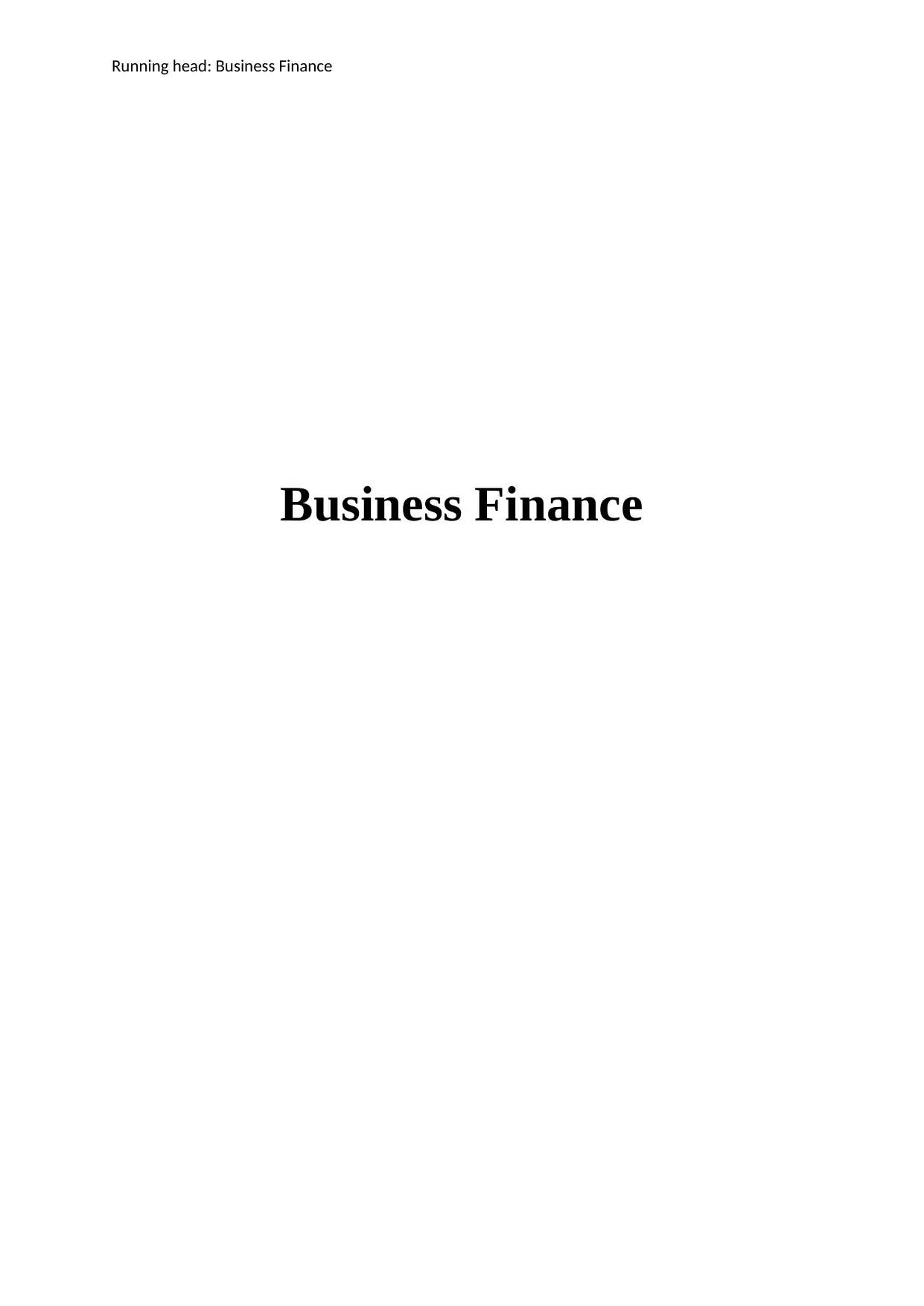
Running head: Business Finance
Business Finance
Business Finance
Paraphrase This Document
Need a fresh take? Get an instant paraphrase of this document with our AI Paraphraser
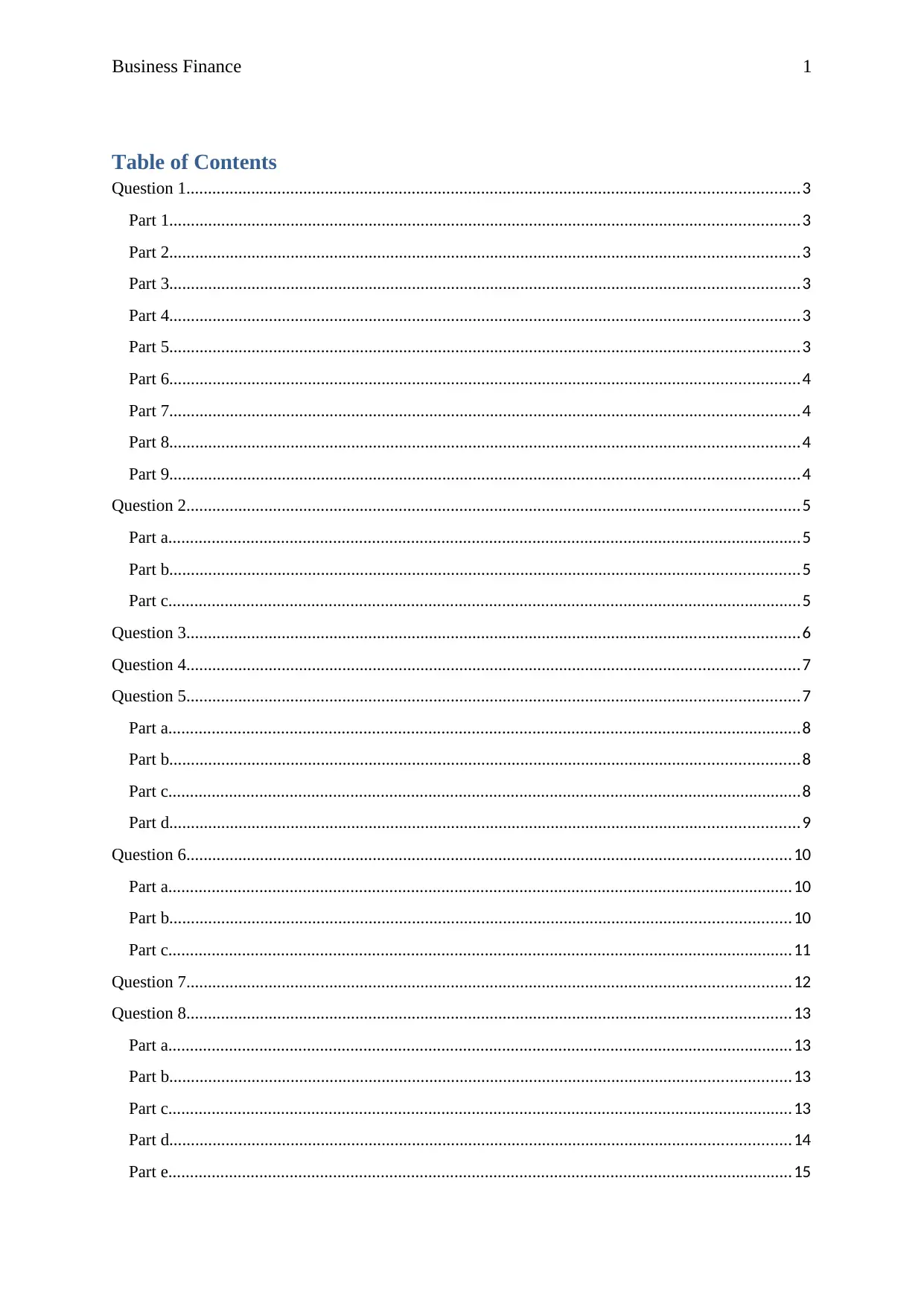
Business Finance 1
Table of Contents
Question 1.............................................................................................................................................3
Part 1.................................................................................................................................................3
Part 2.................................................................................................................................................3
Part 3.................................................................................................................................................3
Part 4.................................................................................................................................................3
Part 5.................................................................................................................................................3
Part 6.................................................................................................................................................4
Part 7.................................................................................................................................................4
Part 8.................................................................................................................................................4
Part 9.................................................................................................................................................4
Question 2.............................................................................................................................................5
Part a..................................................................................................................................................5
Part b.................................................................................................................................................5
Part c..................................................................................................................................................5
Question 3.............................................................................................................................................6
Question 4.............................................................................................................................................7
Question 5.............................................................................................................................................7
Part a..................................................................................................................................................8
Part b.................................................................................................................................................8
Part c..................................................................................................................................................8
Part d.................................................................................................................................................9
Question 6...........................................................................................................................................10
Part a................................................................................................................................................10
Part b...............................................................................................................................................10
Part c................................................................................................................................................11
Question 7...........................................................................................................................................12
Question 8...........................................................................................................................................13
Part a................................................................................................................................................13
Part b...............................................................................................................................................13
Part c................................................................................................................................................13
Part d...............................................................................................................................................14
Part e................................................................................................................................................15
Table of Contents
Question 1.............................................................................................................................................3
Part 1.................................................................................................................................................3
Part 2.................................................................................................................................................3
Part 3.................................................................................................................................................3
Part 4.................................................................................................................................................3
Part 5.................................................................................................................................................3
Part 6.................................................................................................................................................4
Part 7.................................................................................................................................................4
Part 8.................................................................................................................................................4
Part 9.................................................................................................................................................4
Question 2.............................................................................................................................................5
Part a..................................................................................................................................................5
Part b.................................................................................................................................................5
Part c..................................................................................................................................................5
Question 3.............................................................................................................................................6
Question 4.............................................................................................................................................7
Question 5.............................................................................................................................................7
Part a..................................................................................................................................................8
Part b.................................................................................................................................................8
Part c..................................................................................................................................................8
Part d.................................................................................................................................................9
Question 6...........................................................................................................................................10
Part a................................................................................................................................................10
Part b...............................................................................................................................................10
Part c................................................................................................................................................11
Question 7...........................................................................................................................................12
Question 8...........................................................................................................................................13
Part a................................................................................................................................................13
Part b...............................................................................................................................................13
Part c................................................................................................................................................13
Part d...............................................................................................................................................14
Part e................................................................................................................................................15

Business Finance 2
Part f................................................................................................................................................15
Question 9...........................................................................................................................................16
Question 10.........................................................................................................................................17
Part a................................................................................................................................................17
Part b...............................................................................................................................................17
Part c................................................................................................................................................17
Part d...............................................................................................................................................17
Part e................................................................................................................................................17
References:..........................................................................................................................................18
Part f................................................................................................................................................15
Question 9...........................................................................................................................................16
Question 10.........................................................................................................................................17
Part a................................................................................................................................................17
Part b...............................................................................................................................................17
Part c................................................................................................................................................17
Part d...............................................................................................................................................17
Part e................................................................................................................................................17
References:..........................................................................................................................................18
⊘ This is a preview!⊘
Do you want full access?
Subscribe today to unlock all pages.

Trusted by 1+ million students worldwide
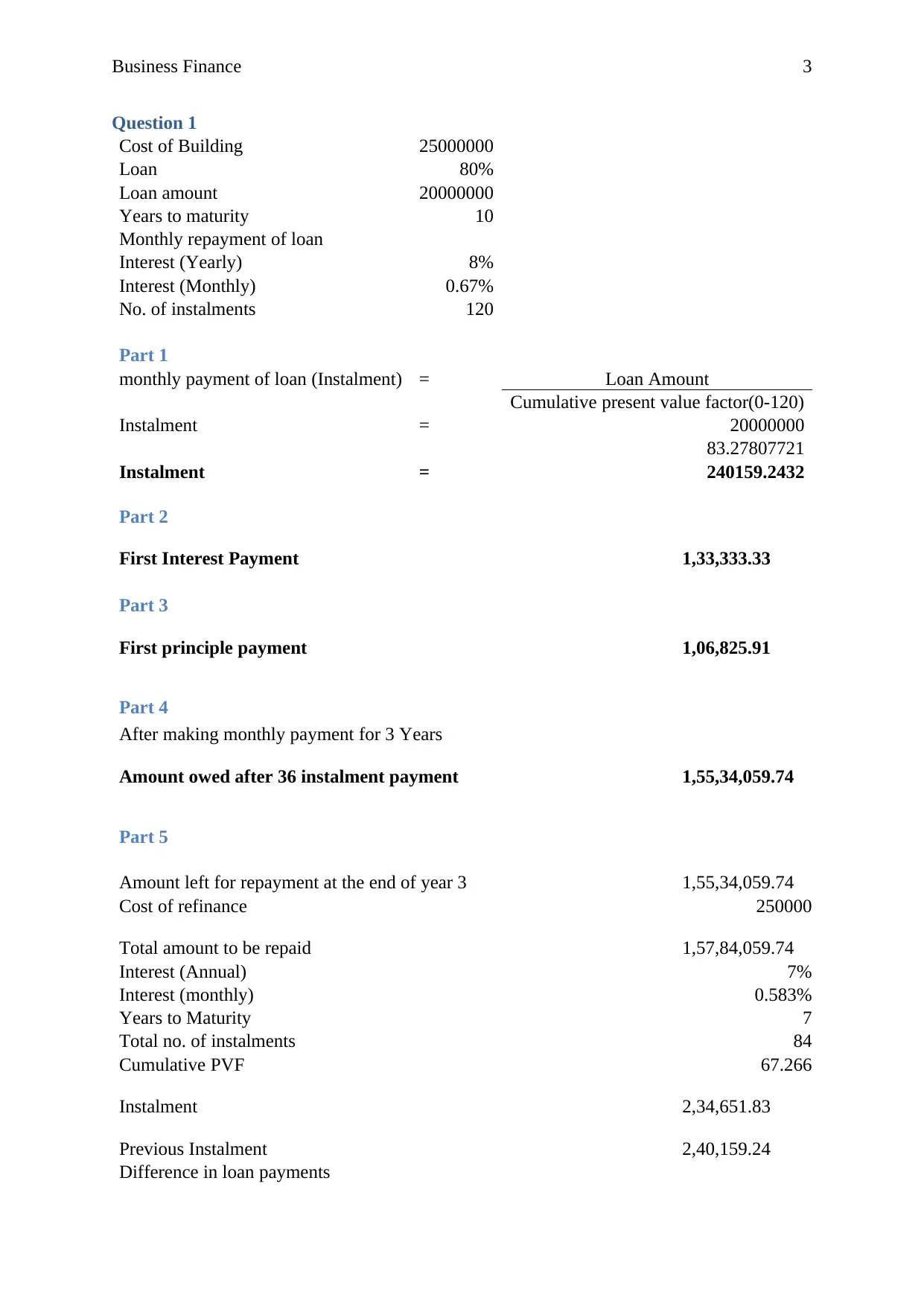
Business Finance 3
Question 1
Cost of Building 25000000
Loan 80%
Loan amount 20000000
Years to maturity 10
Monthly repayment of loan
Interest (Yearly) 8%
Interest (Monthly) 0.67%
No. of instalments 120
Part 1
monthly payment of loan (Instalment) = Loan Amount
Cumulative present value factor(0-120)
Instalment = 20000000
83.27807721
Instalment = 240159.2432
Part 2
First Interest Payment 1,33,333.33
Part 3
First principle payment 1,06,825.91
Part 4
After making monthly payment for 3 Years
Amount owed after 36 instalment payment 1,55,34,059.74
Part 5
Amount left for repayment at the end of year 3 1,55,34,059.74
Cost of refinance 250000
Total amount to be repaid 1,57,84,059.74
Interest (Annual) 7%
Interest (monthly) 0.583%
Years to Maturity 7
Total no. of instalments 84
Cumulative PVF 67.266
Instalment 2,34,651.83
Previous Instalment 2,40,159.24
Difference in loan payments
Question 1
Cost of Building 25000000
Loan 80%
Loan amount 20000000
Years to maturity 10
Monthly repayment of loan
Interest (Yearly) 8%
Interest (Monthly) 0.67%
No. of instalments 120
Part 1
monthly payment of loan (Instalment) = Loan Amount
Cumulative present value factor(0-120)
Instalment = 20000000
83.27807721
Instalment = 240159.2432
Part 2
First Interest Payment 1,33,333.33
Part 3
First principle payment 1,06,825.91
Part 4
After making monthly payment for 3 Years
Amount owed after 36 instalment payment 1,55,34,059.74
Part 5
Amount left for repayment at the end of year 3 1,55,34,059.74
Cost of refinance 250000
Total amount to be repaid 1,57,84,059.74
Interest (Annual) 7%
Interest (monthly) 0.583%
Years to Maturity 7
Total no. of instalments 84
Cumulative PVF 67.266
Instalment 2,34,651.83
Previous Instalment 2,40,159.24
Difference in loan payments
Paraphrase This Document
Need a fresh take? Get an instant paraphrase of this document with our AI Paraphraser
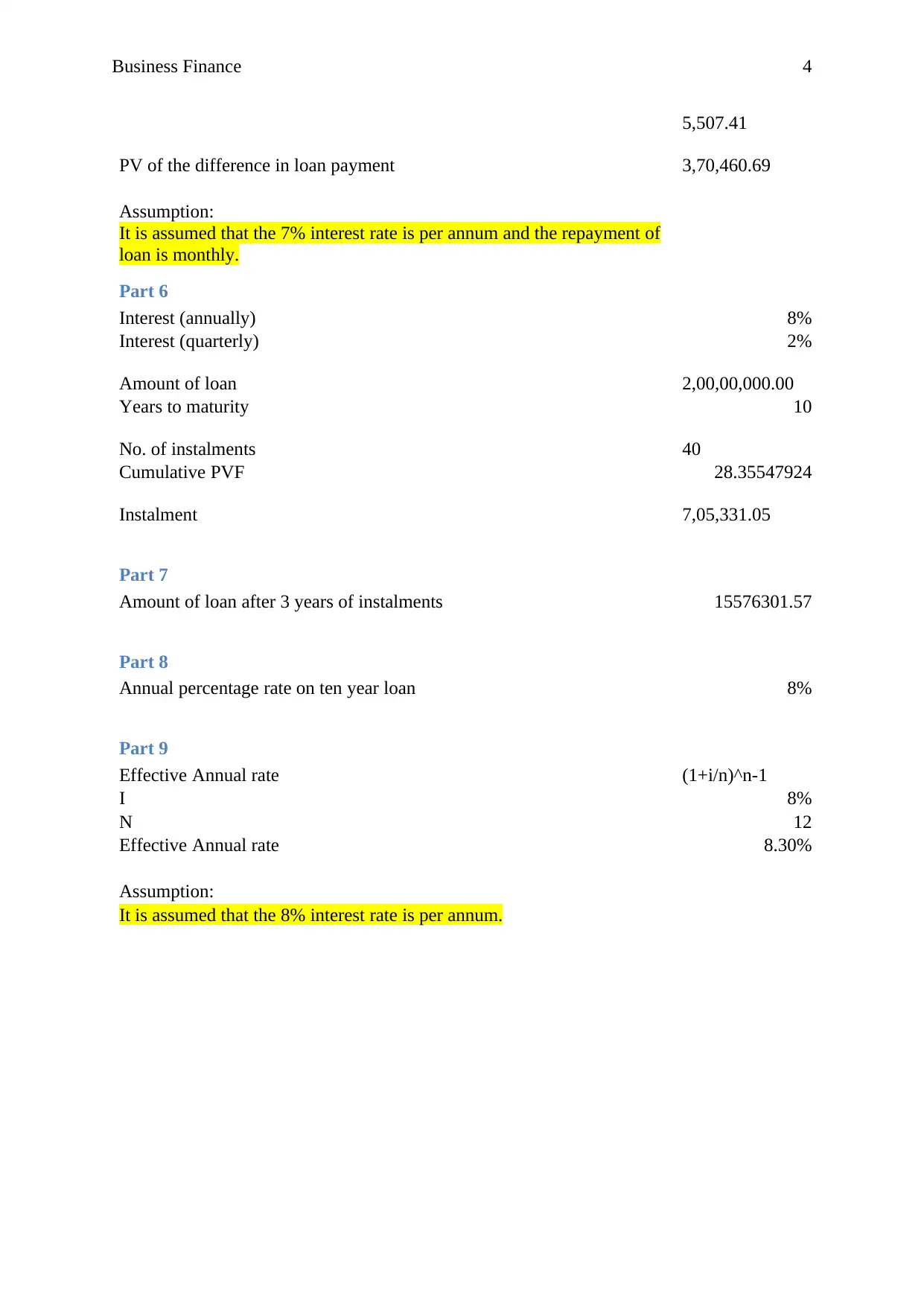
Business Finance 4
5,507.41
PV of the difference in loan payment 3,70,460.69
Assumption:
It is assumed that the 7% interest rate is per annum and the repayment of
loan is monthly.
Part 6
Interest (annually) 8%
Interest (quarterly) 2%
Amount of loan 2,00,00,000.00
Years to maturity 10
No. of instalments 40
Cumulative PVF 28.35547924
Instalment 7,05,331.05
Part 7
Amount of loan after 3 years of instalments 15576301.57
Part 8
Annual percentage rate on ten year loan 8%
Part 9
Effective Annual rate (1+i/n)^n-1
I 8%
N 12
Effective Annual rate 8.30%
Assumption:
It is assumed that the 8% interest rate is per annum.
5,507.41
PV of the difference in loan payment 3,70,460.69
Assumption:
It is assumed that the 7% interest rate is per annum and the repayment of
loan is monthly.
Part 6
Interest (annually) 8%
Interest (quarterly) 2%
Amount of loan 2,00,00,000.00
Years to maturity 10
No. of instalments 40
Cumulative PVF 28.35547924
Instalment 7,05,331.05
Part 7
Amount of loan after 3 years of instalments 15576301.57
Part 8
Annual percentage rate on ten year loan 8%
Part 9
Effective Annual rate (1+i/n)^n-1
I 8%
N 12
Effective Annual rate 8.30%
Assumption:
It is assumed that the 8% interest rate is per annum.
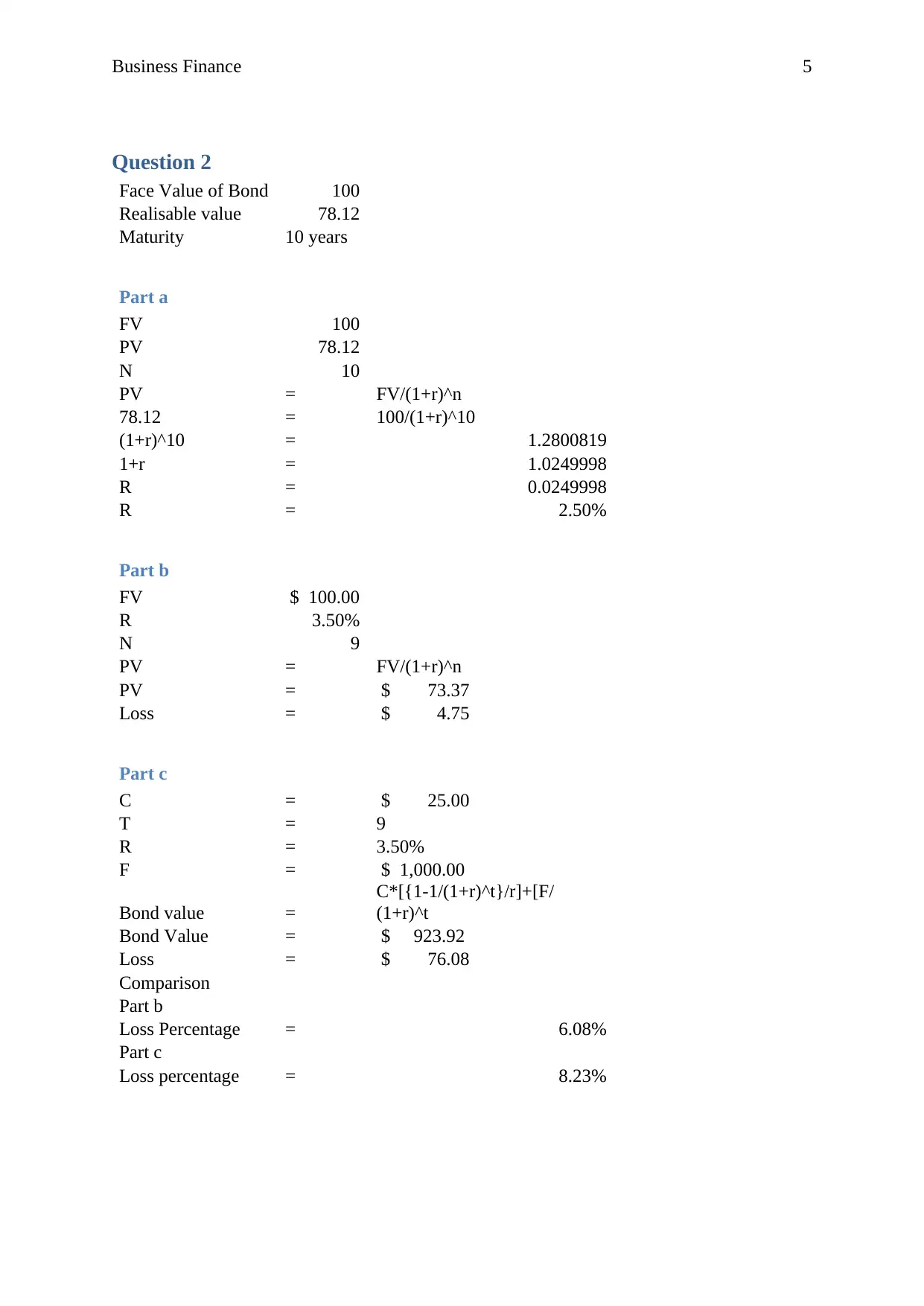
Business Finance 5
Question 2
Face Value of Bond 100
Realisable value 78.12
Maturity 10 years
Part a
FV 100
PV 78.12
N 10
PV = FV/(1+r)^n
78.12 = 100/(1+r)^10
(1+r)^10 = 1.2800819
1+r = 1.0249998
R = 0.0249998
R = 2.50%
Part b
FV $ 100.00
R 3.50%
N 9
PV = FV/(1+r)^n
PV = $ 73.37
Loss = $ 4.75
Part c
C = $ 25.00
T = 9
R = 3.50%
F = $ 1,000.00
Bond value =
C*[{1-1/(1+r)^t}/r]+[F/
(1+r)^t
Bond Value = $ 923.92
Loss = $ 76.08
Comparison
Part b
Loss Percentage = 6.08%
Part c
Loss percentage = 8.23%
Question 2
Face Value of Bond 100
Realisable value 78.12
Maturity 10 years
Part a
FV 100
PV 78.12
N 10
PV = FV/(1+r)^n
78.12 = 100/(1+r)^10
(1+r)^10 = 1.2800819
1+r = 1.0249998
R = 0.0249998
R = 2.50%
Part b
FV $ 100.00
R 3.50%
N 9
PV = FV/(1+r)^n
PV = $ 73.37
Loss = $ 4.75
Part c
C = $ 25.00
T = 9
R = 3.50%
F = $ 1,000.00
Bond value =
C*[{1-1/(1+r)^t}/r]+[F/
(1+r)^t
Bond Value = $ 923.92
Loss = $ 76.08
Comparison
Part b
Loss Percentage = 6.08%
Part c
Loss percentage = 8.23%
⊘ This is a preview!⊘
Do you want full access?
Subscribe today to unlock all pages.

Trusted by 1+ million students worldwide

Business Finance 6
Question 3
Price of shares today
D1 3.28
G 5%
Ke 11%
Po = D1/(Ke-g)
Po = 54.67
Rate of return
D1 (Expected dividend) 3.7
Po 54.67
G 0.05
Ke ?
Ke = (D1/Po)+g
Ke = 12%
Question 3
Price of shares today
D1 3.28
G 5%
Ke 11%
Po = D1/(Ke-g)
Po = 54.67
Rate of return
D1 (Expected dividend) 3.7
Po 54.67
G 0.05
Ke ?
Ke = (D1/Po)+g
Ke = 12%
Paraphrase This Document
Need a fresh take? Get an instant paraphrase of this document with our AI Paraphraser
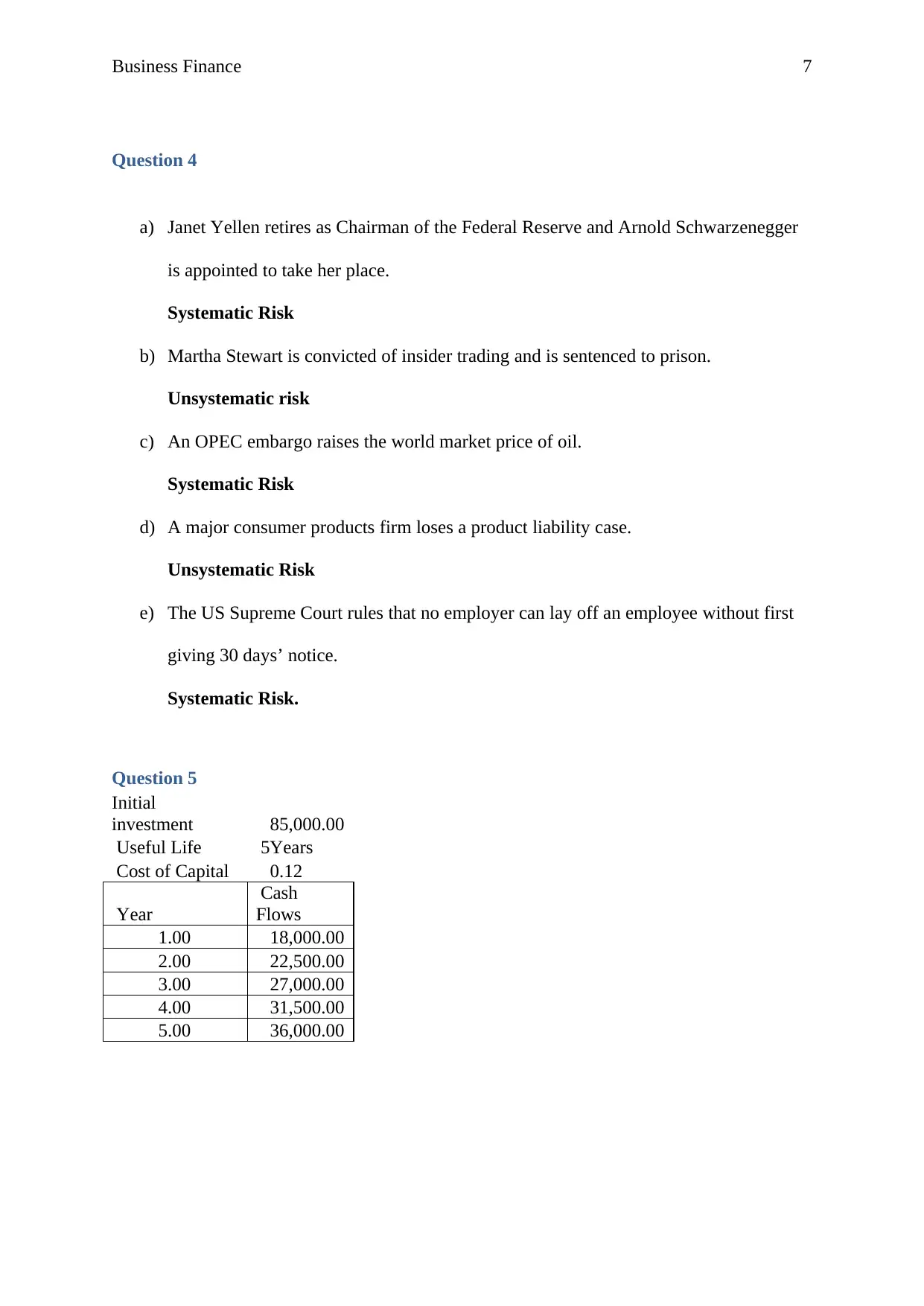
Business Finance 7
Question 4
a) Janet Yellen retires as Chairman of the Federal Reserve and Arnold Schwarzenegger
is appointed to take her place.
Systematic Risk
b) Martha Stewart is convicted of insider trading and is sentenced to prison.
Unsystematic risk
c) An OPEC embargo raises the world market price of oil.
Systematic Risk
d) A major consumer products firm loses a product liability case.
Unsystematic Risk
e) The US Supreme Court rules that no employer can lay off an employee without first
giving 30 days’ notice.
Systematic Risk.
Question 5
Initial
investment 85,000.00
Useful Life 5Years
Cost of Capital 0.12
Year
Cash
Flows
1.00 18,000.00
2.00 22,500.00
3.00 27,000.00
4.00 31,500.00
5.00 36,000.00
Question 4
a) Janet Yellen retires as Chairman of the Federal Reserve and Arnold Schwarzenegger
is appointed to take her place.
Systematic Risk
b) Martha Stewart is convicted of insider trading and is sentenced to prison.
Unsystematic risk
c) An OPEC embargo raises the world market price of oil.
Systematic Risk
d) A major consumer products firm loses a product liability case.
Unsystematic Risk
e) The US Supreme Court rules that no employer can lay off an employee without first
giving 30 days’ notice.
Systematic Risk.
Question 5
Initial
investment 85,000.00
Useful Life 5Years
Cost of Capital 0.12
Year
Cash
Flows
1.00 18,000.00
2.00 22,500.00
3.00 27,000.00
4.00 31,500.00
5.00 36,000.00

Business Finance 8
Part a
Payback Period
Year
Cash
Flows Cumulative cash Flows
1.00 18,000.00 18,000.00
2.00 22,500.00 40,500.00
3.00 27,000.00 67,500.00
4.00 31,500.00 99,000.00
5.00 36,000.00 1,35,000.00
Payback
Period = 3.56
Part b
Year
Cash
Flows
PVF @
12% PV of cash flows
-
-
85,000.00 1.00 -85,000.00
1.00 18,000.00 0.89 16,071.43
2.00 22,500.00 0.80 17,936.86
3.00 27,000.00 0.71 19,218.07
4.00 31,500.00 0.64 20,018.82
5.00 36,000.00 0.57 20,427.37
NPV 8,672.54
Part c
Year
Cash
Flows
PVF @
20%
PV of cash
flows
PVF @
15%
PV of cash
flows
-
-
85,000.00 1.00 -85,000.00 1.00 -85,000.00
1.00 18,000.00 0.83 15,000.00 0.87 15,652.17
2.00 22,500.00 0.69 15,625.00 0.76 17,013.23
3.00 27,000.00 0.58 15,625.00 0.66 17,752.94
4.00 31,500.00 0.48 15,190.97 0.57 18,010.23
Part a
Payback Period
Year
Cash
Flows Cumulative cash Flows
1.00 18,000.00 18,000.00
2.00 22,500.00 40,500.00
3.00 27,000.00 67,500.00
4.00 31,500.00 99,000.00
5.00 36,000.00 1,35,000.00
Payback
Period = 3.56
Part b
Year
Cash
Flows
PVF @
12% PV of cash flows
-
-
85,000.00 1.00 -85,000.00
1.00 18,000.00 0.89 16,071.43
2.00 22,500.00 0.80 17,936.86
3.00 27,000.00 0.71 19,218.07
4.00 31,500.00 0.64 20,018.82
5.00 36,000.00 0.57 20,427.37
NPV 8,672.54
Part c
Year
Cash
Flows
PVF @
20%
PV of cash
flows
PVF @
15%
PV of cash
flows
-
-
85,000.00 1.00 -85,000.00 1.00 -85,000.00
1.00 18,000.00 0.83 15,000.00 0.87 15,652.17
2.00 22,500.00 0.69 15,625.00 0.76 17,013.23
3.00 27,000.00 0.58 15,625.00 0.66 17,752.94
4.00 31,500.00 0.48 15,190.97 0.57 18,010.23
⊘ This is a preview!⊘
Do you want full access?
Subscribe today to unlock all pages.

Trusted by 1+ million students worldwide

Business Finance 9
5.00 36,000.00 0.40 14,467.59 0.50 17,898.36
-9,091.44 1,326.93
IRR = 16%
Part d
The investment can be done in this project as NPV of the project is positive and the IRR is
more than the company’s rate of return. The company can implement the project as the NPV
and IRR both have positive implication on the acceptability of the project. Positive NPV
shows that companies’ profits will increase gradually with the acceptance of the project.
5.00 36,000.00 0.40 14,467.59 0.50 17,898.36
-9,091.44 1,326.93
IRR = 16%
Part d
The investment can be done in this project as NPV of the project is positive and the IRR is
more than the company’s rate of return. The company can implement the project as the NPV
and IRR both have positive implication on the acceptability of the project. Positive NPV
shows that companies’ profits will increase gradually with the acceptance of the project.
Paraphrase This Document
Need a fresh take? Get an instant paraphrase of this document with our AI Paraphraser
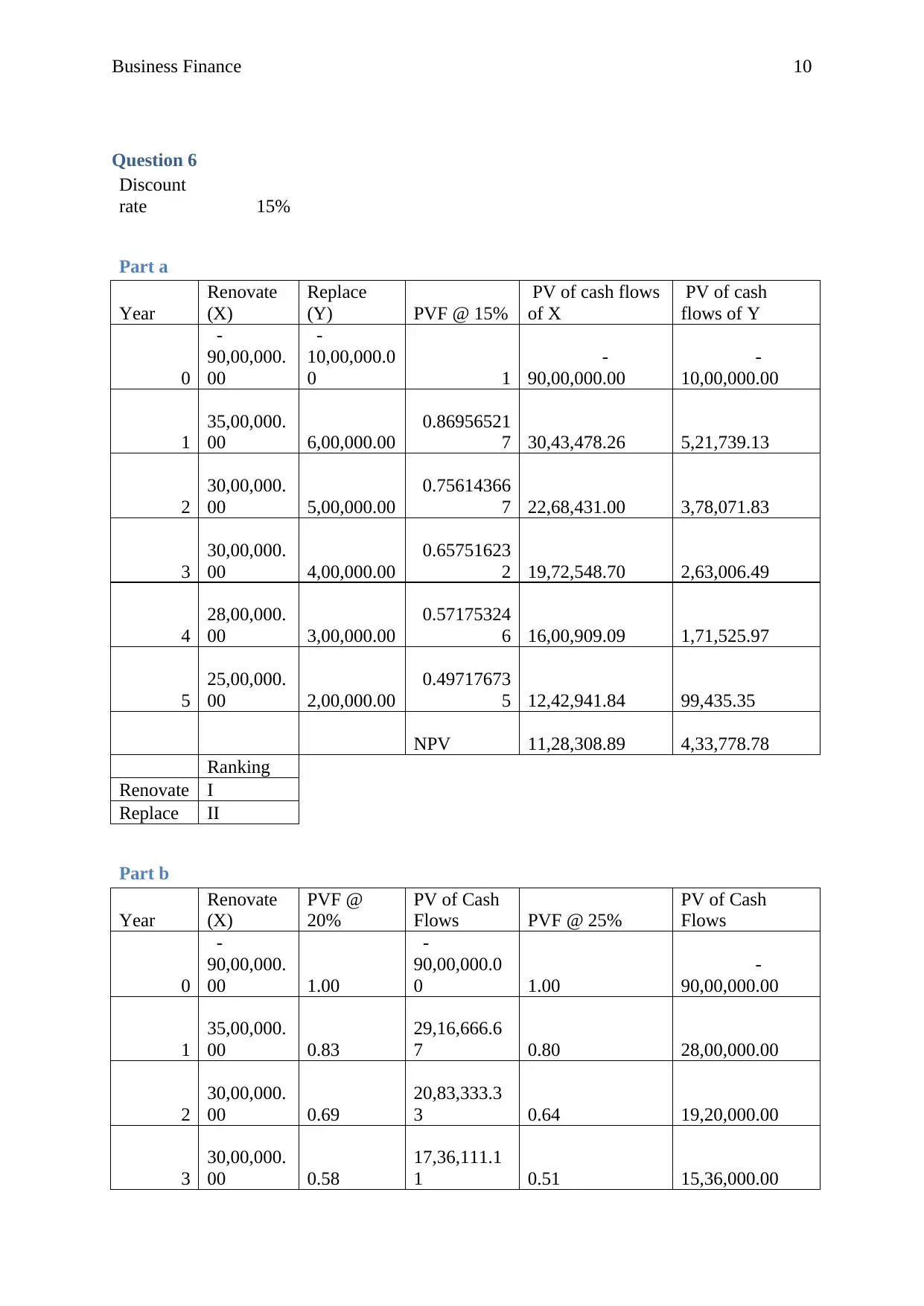
Business Finance 10
Question 6
Discount
rate 15%
Part a
Year
Renovate
(X)
Replace
(Y) PVF @ 15%
PV of cash flows
of X
PV of cash
flows of Y
0
-
90,00,000.
00
-
10,00,000.0
0 1
-
90,00,000.00
-
10,00,000.00
1
35,00,000.
00 6,00,000.00
0.86956521
7 30,43,478.26 5,21,739.13
2
30,00,000.
00 5,00,000.00
0.75614366
7 22,68,431.00 3,78,071.83
3
30,00,000.
00 4,00,000.00
0.65751623
2 19,72,548.70 2,63,006.49
4
28,00,000.
00 3,00,000.00
0.57175324
6 16,00,909.09 1,71,525.97
5
25,00,000.
00 2,00,000.00
0.49717673
5 12,42,941.84 99,435.35
NPV 11,28,308.89 4,33,778.78
Ranking
Renovate I
Replace II
Part b
Year
Renovate
(X)
PVF @
20%
PV of Cash
Flows PVF @ 25%
PV of Cash
Flows
0
-
90,00,000.
00 1.00
-
90,00,000.0
0 1.00
-
90,00,000.00
1
35,00,000.
00 0.83
29,16,666.6
7 0.80 28,00,000.00
2
30,00,000.
00 0.69
20,83,333.3
3 0.64 19,20,000.00
3
30,00,000.
00 0.58
17,36,111.1
1 0.51 15,36,000.00
Question 6
Discount
rate 15%
Part a
Year
Renovate
(X)
Replace
(Y) PVF @ 15%
PV of cash flows
of X
PV of cash
flows of Y
0
-
90,00,000.
00
-
10,00,000.0
0 1
-
90,00,000.00
-
10,00,000.00
1
35,00,000.
00 6,00,000.00
0.86956521
7 30,43,478.26 5,21,739.13
2
30,00,000.
00 5,00,000.00
0.75614366
7 22,68,431.00 3,78,071.83
3
30,00,000.
00 4,00,000.00
0.65751623
2 19,72,548.70 2,63,006.49
4
28,00,000.
00 3,00,000.00
0.57175324
6 16,00,909.09 1,71,525.97
5
25,00,000.
00 2,00,000.00
0.49717673
5 12,42,941.84 99,435.35
NPV 11,28,308.89 4,33,778.78
Ranking
Renovate I
Replace II
Part b
Year
Renovate
(X)
PVF @
20%
PV of Cash
Flows PVF @ 25%
PV of Cash
Flows
0
-
90,00,000.
00 1.00
-
90,00,000.0
0 1.00
-
90,00,000.00
1
35,00,000.
00 0.83
29,16,666.6
7 0.80 28,00,000.00
2
30,00,000.
00 0.69
20,83,333.3
3 0.64 19,20,000.00
3
30,00,000.
00 0.58
17,36,111.1
1 0.51 15,36,000.00

Business Finance 11
4
28,00,000.
00 0.48
13,50,308.6
4 0.41 11,46,880.00
5
25,00,000.
00 0.40
10,04,693.9
3 0.33 8,19,200.00
NPV 91,113.68 NPV
-
7,77,920.00
IRR 20.49%
Year
Replace
(Y)
PVF @
30%
PV of Cash
Flows PVF @ 40%
PV of Cash
Flows
0
-
10,00,000.
00 1.00
-
10,00,000.0
0 1.00
-
10,00,000.00
1
6,00,000.0
0 0.77 4,61,538.46 0.71 4,28,571.43
2
5,00,000.0
0 0.59 2,95,857.99 0.51 2,55,102.04
3
4,00,000.0
0 0.46 1,82,066.45 0.36 1,45,772.59
4
3,00,000.0
0 0.35 1,05,038.34 0.26 78,092.46
5
2,00,000.0
0 0.27 53,865.81 0.19 37,186.89
NPV 98,367.06 NPV
-
55,274.59
IRR 36%
Ranking
Renovate II
Replace I
Part c
These rankings give mixed signals as NPV is the difference between initial investment and
present value of cash inflows and IRR is the rate at which PV of cash outflows (Initial
Investment is equal to Present value of cash inflows (Titman, Keown, & Martin, 2017)..
4
28,00,000.
00 0.48
13,50,308.6
4 0.41 11,46,880.00
5
25,00,000.
00 0.40
10,04,693.9
3 0.33 8,19,200.00
NPV 91,113.68 NPV
-
7,77,920.00
IRR 20.49%
Year
Replace
(Y)
PVF @
30%
PV of Cash
Flows PVF @ 40%
PV of Cash
Flows
0
-
10,00,000.
00 1.00
-
10,00,000.0
0 1.00
-
10,00,000.00
1
6,00,000.0
0 0.77 4,61,538.46 0.71 4,28,571.43
2
5,00,000.0
0 0.59 2,95,857.99 0.51 2,55,102.04
3
4,00,000.0
0 0.46 1,82,066.45 0.36 1,45,772.59
4
3,00,000.0
0 0.35 1,05,038.34 0.26 78,092.46
5
2,00,000.0
0 0.27 53,865.81 0.19 37,186.89
NPV 98,367.06 NPV
-
55,274.59
IRR 36%
Ranking
Renovate II
Replace I
Part c
These rankings give mixed signals as NPV is the difference between initial investment and
present value of cash inflows and IRR is the rate at which PV of cash outflows (Initial
Investment is equal to Present value of cash inflows (Titman, Keown, & Martin, 2017)..
⊘ This is a preview!⊘
Do you want full access?
Subscribe today to unlock all pages.

Trusted by 1+ million students worldwide
1 out of 19
Related Documents
Your All-in-One AI-Powered Toolkit for Academic Success.
+13062052269
info@desklib.com
Available 24*7 on WhatsApp / Email
![[object Object]](/_next/static/media/star-bottom.7253800d.svg)
Unlock your academic potential
Copyright © 2020–2025 A2Z Services. All Rights Reserved. Developed and managed by ZUCOL.


